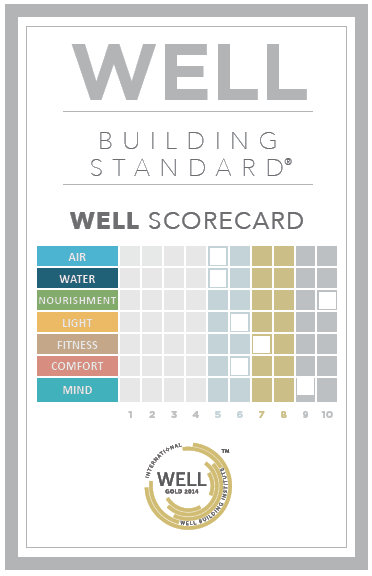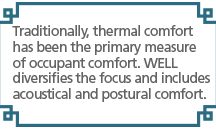WELL Buildings
The WELL Building Standard, or WELL, focuses attention solely on the health and wellness of building occupants. WELL was pioneered by Delos, is administered by
International WELL Building Institute (IWBI), and is third-party certified through IWBI’s collaboration with Green Business Certification Inc. (GBCI).

*Image from wellcertified.com
Why WELL & Why Now?
According to the Global Wellness Institute research, wellness is one of the world’s fastest growing, most resilient markets – clocking in a 10% growth while the global economy shrank by -3.6%/ Workplace wellness and wellness lifestyle real estate is a $162 billion dollar industry.
In the U.S., more than 120 million employees spend an average of 8.1 hours within a building each day. It is no surprise that health and wellness are considered as a key driver of owner/occupant satisfaction. Surveys demonstrate that 84% of U.S. based companies plan to increase health and productivity program support over the next two years. The green building industry is realizing that it has been concentrating on 1-3% of the pie, while health and wellness directly affect 95% of an owners expenses (benefits, salaries, and absenteeism).
WELL Building Standard
WELL is applicable to new construction, major renovations, tenant improvements, and core and shell developments. Pilot programs are available for educational buildings, sports facilities, retail stores, and healthcare facilities.
 The standard is a set of 102 individual features with 209 (sub)parts sorted into seven categories: Air, Water, Nourishment, Light, Fitness, Comfort, and Mind. Each concept includes preconditions that are compulsory and optimizations that are optional depending on the level of certification pursued. Similar to LEED, the certification levels include Silver, Gold and Platinum. However, unlike LEED certification for New Construction, WELL certification must be recertified every three years based on actual building data. The standard provides a performance-based framework to measure and evaluate a building’s impact on occupants. The standard sheds light on how each WELL feature directly impacts the eleven body systems (eg. cardiovascular, respiratory, endocrine, immune body systems).
The standard is a set of 102 individual features with 209 (sub)parts sorted into seven categories: Air, Water, Nourishment, Light, Fitness, Comfort, and Mind. Each concept includes preconditions that are compulsory and optimizations that are optional depending on the level of certification pursued. Similar to LEED, the certification levels include Silver, Gold and Platinum. However, unlike LEED certification for New Construction, WELL certification must be recertified every three years based on actual building data. The standard provides a performance-based framework to measure and evaluate a building’s impact on occupants. The standard sheds light on how each WELL feature directly impacts the eleven body systems (eg. cardiovascular, respiratory, endocrine, immune body systems).
The standard sheds light on how each WELL feature directly impacts the eleven body systems (eg -cardiovascular, respiratory, endocrine, immune body systems). Knowing how the design and operation decisions of our buildings impact each of these body systems is a key aspect in the standard.
For example, research shows that exercising 2.5 hours a week decreases mortality by 20%. Scientific studies such as this have translated into features that promote interior fitness circulation and physical activity incentive programs. WELL encourages designing stairs within 25 feet of the entrance lobby. It also requires signage encouraging people to use the stairs. Encouraging behavior modification through design/operation of buildings is one of the core principles of the WELL Standard. There are currently 14 certified and 166 registered projects in the United States.
As we continue to push the boundaries and pursue this certification, we hope that much like the Living Building Challenge, the WELL Building Standard can inspire long-term change in the way the built environment affects us.
Newcomb & Boyd would like to partner with you to inspire this change. Contact us HERE
 |
 |
